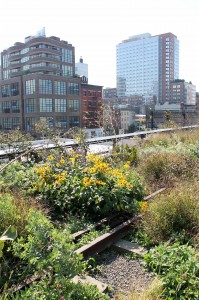The Gardens Above
September 18th, 2012
I got a look last week at one of the rising stars (in more ways than one) of the planted world — New York’s High Line.
The High Line is a once-abandoned, elevated Manhattan rail line that’s been turned into a park — or “aerial greenway,” as some call it.
It’s a novel rebirth that’s getting a lot of attention lately as a model for green urban renewal. People apparently are very curious to see it.
Our Lowee’s bus trip there, for example, sold out and had a waiting list. Manhattan locals are complaining that the site, which had 3.7 million visitors last year, is fast becoming a tourist trap (as if tons of people isn’t already the norm in Manhattan).
I generally liked the concept. Instead of a rust and concrete eyesore hanging 30 feet over the streets, there’s now a greenscape of trees, grasses and wildflowers with plenty of seating and nice views into the New York harbor.
One area is a beach-like setting with sumac trees shading large deck chairs and a thin sheet of water sliding across part of the walk.
Another area is a swath of lawn, and another features a grove of birch trees. Most of the 1½-mile planted pathway is filled with assorted native grasses and perennials, such as switchgrass, amsonia, asters and ironweed.
We take this kind of setting for granted. Gardens, parks and green spaces are all over suburbia. But for New Yorkers, this is a big deal. To be able to sit under a shade tree, lie on a lawn or watch a butterfly flit on a flower is a treat.
Most everyone likes this slice of nature on stilts and the improvement it’s brought to the surrounding West Side.
The main complaint is that rising rents have forced out some long-time businesses and residents (as well as the aforementioned rise in visitor traffic).
What I’m not so sure all visitors are going to like is the naturalistic planting scheme. If you go expecting gardens in the traditional sense, you won’t find any.
The plantings are arranged in seemingly random sweeps of grasses and wildflowers with gravel mulch underneath and sections of rails interspersed to remind of the site’s past.
A lot of it is flopping over itself. Green is the predominant color.
I’m sure some people will look at this and say, “Isn’t this great for nature?”
I’m also sure others will look at it and say, “This needs a good trim,” or “I don’t see much difference between now and when it was growing wild.”
I think it would’ve been a good compromise to do a little of both up there — some naturalistic plantings and some more formal beds with trimmed shrubs and annuals.
It reminded me a bit of the reaction in Lemoyne after the borough added rain gardens filled with all native plants along Market Street. Lots of people said the plantings looked like weeds and wondered where the “real flowers” were.
Whether you like the plant choice or not, the High Line is a lot more interesting and useful than before. It sure beats a rust-bucket in the sky. If you want to see and read more about the High Line, here’s the web site: www.thehighline.org.









